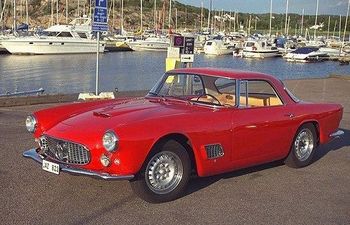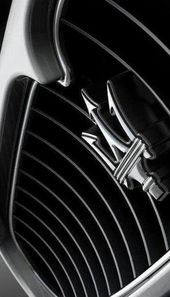.
Maserati 3500: Difference between revisions
Red marquis (talk | contribs) No edit summary |
No edit summary |
||
| Line 43: | Line 43: | ||
| [[Carrozzeria Touring]] | | [[Carrozzeria Touring]] | ||
|} | |} | ||
'''Maserati 3500''' was a 2-door [[coupé]] and [[convertible]] made by [[Maserati]] of | '''Maserati 3500''' was a 2-door [[coupé]] and [[convertible]] made by [[Maserati]] of Italy, being the company's first attempt at the [[Gran Turismo]] market and large-volume production. | ||
Maserati's chief engineer | Maserati's chief engineer Giulio Alfieri developed the two 2+2 prototype '''3500GT''', revealed at the [[Salon International de l'Auto]] in Geneva, March 1957. | ||
Both had a 2600 mm wheelbase and | Both had a 2600 mm wheelbase and aluminum bodywork; one a [[superleggera]] body by [[Carrozzeria Touring]] of Milan, the other by [[Carrozzeria Allemano]]. | ||
The design incorporated | The design incorporated | ||
*[[Maserati 350S]]-derived [[straight-six]] cylinder, [[DOHC]] 3485 ccm litre 42 DCOE [[Weber carburetor]] engine (220 bhp at 5500 rpm), | *[[Maserati 350S]]-derived [[straight-six]] cylinder, [[DOHC]] 3485 ccm litre 42 DCOE [[Weber carburetor]] engine (220 bhp at 5500 rpm), | ||
| Line 54: | Line 54: | ||
*[[Borg & Beck]]-made single-plate dry [[clutch]], | *[[Borg & Beck]]-made single-plate dry [[clutch]], | ||
*live rear axle, [[differential (mechanics)]] by [[Salisbury]], | *live rear axle, [[differential (mechanics)]] by [[Salisbury]], | ||
*[[suspension (mechanical)|suspension]] by | *[[suspension (mechanical)|suspension]] by Alford & Alder: Front wishbone and coil-springed suspension; rear semielliptic springs. | ||
*16" steel wheels with 6.5" | *16" steel wheels with 6.5" Pirelli ''Cinturato'' diagonal tires. | ||
Minor design changes were done before production of the 1420 kg Touring-based body | Minor design changes were done before production of the 1420 kg Touring-based body | ||
started late 1957. | started late 1957. | ||
| Line 62: | Line 62: | ||
[[Borrani]] knock-out wire wheels complemented the standard steel wheels, | [[Borrani]] knock-out wire wheels complemented the standard steel wheels, | ||
as well as wider 185x16" radial tyres. All cars had leather interior and | as well as wider 185x16" radial tyres. All cars had leather interior and | ||
Jaeger-LeCoultre instruments. | |||
Power windows was added as standard. | Power windows was added as standard. | ||
In 1959 the [[Maserati 5000 GT]] was introduced, using the chassis of the 3500GT. | In 1959 the [[Maserati 5000 GT]] was introduced, using the chassis of the 3500GT. | ||
Two steel-bodied convertible prototypes by [[Carrozzeria Vignale]] and [[Michelotti]] were developed in 1959 and shown at the [[Mondial de l'Automobile]] in | Two steel-bodied convertible prototypes by [[Carrozzeria Vignale]] and [[Michelotti]] were developed in 1959 and shown at the [[Mondial de l'Automobile]] in Paris 1959. | ||
The Vignale version went into production in 1960, as the '''3500 GTs''' or just «Vignale spider», and had a shortened 2499 mm chassis weighing 1380 kg. | The Vignale version went into production in 1960, as the '''3500 GTs''' or just «Vignale spider», and had a shortened 2499 mm chassis weighing 1380 kg. | ||
| Line 76: | Line 76: | ||
The first year (1958) sold 119 cars, 1961 was the best-selling year | The first year (1958) sold 119 cars, 1961 was the best-selling year | ||
totalling 500. All together, | totalling 500. All together, | ||
242 Vignale convertibles and nearly 2000 coupes were manufactured, of these, 1973 being Touring coupe, the rest were bodied by other coachbuildes, [[Carrozzeria Allemano]] (four coupes, including the 1957 prototype), [[Zagato]] (one coupe, 1957), [[Carrozzeria Boneschi]] (two cars; 1962, 1963 [[Salone dell'automobile di Torino]], 1962); [[Salon International de l'Auto]] in | 242 Vignale convertibles and nearly 2000 coupes were manufactured, of these, 1973 being Touring coupe, the rest were bodied by other coachbuildes, [[Carrozzeria Allemano]] (four coupes, including the 1957 prototype), [[Zagato]] (one coupe, 1957), [[Carrozzeria Boneschi]] (two cars; 1962, 1963 [[Salone dell'automobile di Torino]], 1962); [[Salon International de l'Auto]] in Geneva, 1963), [[Frua]] (two or three coupes, one spider) and [[Bertone]] (one coupe). The last was a coupe by [[Moretti]] ([[Salon International de l'Auto]] in [[Geneva]], 1966). | ||
==External links== | ==External links== | ||
Revision as of 12:04, 8 December 2006
| Maserati 3500 GT | |
|---|---|

| |
| Manufacturer | Maserati |
| Production | 1957–1964 |
| Class | Grand Tourer |
| Body style | 2+2 coupé, 2-seat spyder |
| Lengh | |
| Width | |
| Wheelbase | 2600 mm |
| Weight | 1466 kg (dry) |
| Transmission | ZF 4 speed and reverse (5-speed from 1961), Rear wheel drive |
| Engine | 3485.3cc Inline-Six, Three twin-choke 42 DCOE Weber carburettors (1957-1960), Lucas direct fuel injection (1961-1964) |
| Power | 220 bhp @ 5500 rpm (235 bhp @ 5500 rpm) |
| Similar | Ferrari 250 Aston Martin DB4 Maserati Sebring |
| Designer | Carrozzeria Touring |
Maserati 3500 was a 2-door coupé and convertible made by Maserati of Italy, being the company's first attempt at the Gran Turismo market and large-volume production.
Maserati's chief engineer Giulio Alfieri developed the two 2+2 prototype 3500GT, revealed at the Salon International de l'Auto in Geneva, March 1957. Both had a 2600 mm wheelbase and aluminum bodywork; one a superleggera body by Carrozzeria Touring of Milan, the other by Carrozzeria Allemano. The design incorporated
- Maserati 350S-derived straight-six cylinder, DOHC 3485 ccm litre 42 DCOE Weber carburetor engine (220 bhp at 5500 rpm),
- mechanical Magneti-Marelli ignition, dual spark plugs and dual fuelpump
- 4-speed ZF S4-17 gearbox (2.98:1, 1.99:1, 1.34:1, 1:1),
- Girling 12" turbofinned drum brakes front and rear
- Borg & Beck-made single-plate dry clutch,
- live rear axle, differential (mechanics) by Salisbury,
- suspension by Alford & Alder: Front wishbone and coil-springed suspension; rear semielliptic springs.
- 16" steel wheels with 6.5" Pirelli Cinturato diagonal tires.
Minor design changes were done before production of the 1420 kg Touring-based body started late 1957. Front disc brakes and limited slip differential became optional in 1959, standardized in 1960; rear discs became standard in 1962. Borrani knock-out wire wheels complemented the standard steel wheels, as well as wider 185x16" radial tyres. All cars had leather interior and Jaeger-LeCoultre instruments. Power windows was added as standard.
In 1959 the Maserati 5000 GT was introduced, using the chassis of the 3500GT. Two steel-bodied convertible prototypes by Carrozzeria Vignale and Michelotti were developed in 1959 and shown at the Mondial de l'Automobile in Paris 1959. The Vignale version went into production in 1960, as the 3500 GTs or just «Vignale spider», and had a shortened 2499 mm chassis weighing 1380 kg.
The 3500 GTi and 3500 GTis was introduced in 1961 as the first fuel-injected Italian production car. It had a Lucas fuel injection (235 bhp). A 5-speed ZF S5-17 gearbox was now standard (3.02:1, 1.85:1, 1.29:1, 1:1, 0.85:1), as well as disc brakes all round. The body had a lowered roofline and become somewhat longer; minor outward changes appeared as well (new grille, rear lights, vent windows). The rather similar Maserati Sebring also a 2+2 coupe entered production in 1962.
The first year (1958) sold 119 cars, 1961 was the best-selling year totalling 500. All together, 242 Vignale convertibles and nearly 2000 coupes were manufactured, of these, 1973 being Touring coupe, the rest were bodied by other coachbuildes, Carrozzeria Allemano (four coupes, including the 1957 prototype), Zagato (one coupe, 1957), Carrozzeria Boneschi (two cars; 1962, 1963 Salone dell'automobile di Torino, 1962); Salon International de l'Auto in Geneva, 1963), Frua (two or three coupes, one spider) and Bertone (one coupe). The last was a coupe by Moretti (Salon International de l'Auto in Geneva, 1966).
External links
- maserati-alfieri.co.uk on the 3500

